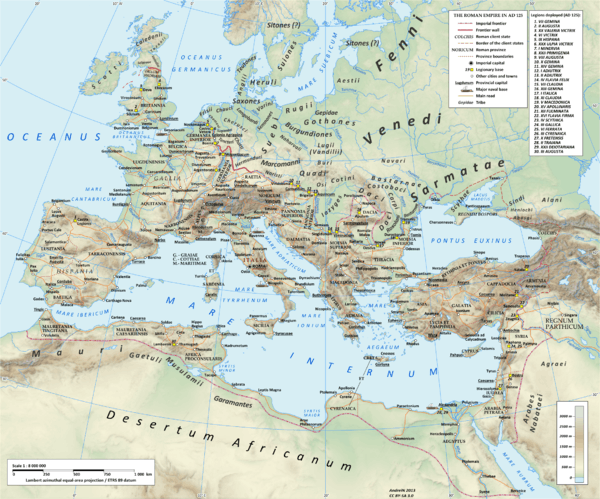Legio XXII Deiotariana

Legio vigesima secunda Deiotariana ("Deiotarus'Twenty-Second Legion") was a legion of the Imperial Roman army, founded ca. 48 BC and disbanded during the Bar Kokhba revolt of 132–135. Its cognomen comes from Deiotarus, a Celtic king of Galatia. Its emblem is unknown.
Legion history
Origin of the legion
The legion was levied by Deiotarus, king of the Celtic tribe of the Tolistobogii, who lived in Galatia, modern Turkey. Deiotarus became an ally of the Roman Republic's general Pompey in 63 BC, who named him king of all the Celtic tribes of Asia minor, which were collectively known as Galatians (hence the name Galatia for the region). Deiotarus levied an army and trained it with Roman help; the army, in 48 BC, was composed of 12,000 infantrymen and 2,000 horsemen. Cicero writes that the army was divided into to thirty cohortes, which were roughly equivalent to three Roman legions of the time. This army supported the Romans in their wars against king Mithridates VI of Pontus, and contributed to Roman victory in the Third Mithridatic War.
After a heavy defeat against king Pharnaces II of Pontus near Nicopolis, the survivor soldiers of Deiotarius army formed a single legion, which marched besides Julius Caesar during his victorious campaign against Pontus, and fought with him in the battle of Zela (47 BC).
Early history (BC)
When the Roman Empire integrated the Galatian kingdom, this legion, which had been trained by the Romans and had fought under Roman commanders, became part of the Roman army; since Caesar Augustus had already 21 legions, the legion received the number XXII.
Augustus sent the Twenty-second to camp in Nicopolis (next Alexandria, in Aegyptus) together with III Cyrenaica. These two legions had the role of garrisoning the Egyptian province from threats both within and without, given the multi-ethnical nature of Alexandria.
In 26 BC, Aelius Gallus, praefectus Aegypti (prefectus of Egypt), led a campaign against the Nubian kingdoms and another to find Arabia Felix (Yemen). The campaign came quickly to a halt (25 BC) because of the heavy losses in the troops (Romans, Hebrews and Nabateans), due to hunger and epidemics.
The losses were not recovered, so in 23 BC the Nubians, led by queen Candace Amanirenas, took the initiative and attacked the Romans moving towards Elephantine. The new prefectus of Egypt, Petronius, obtained reinforcements, and after blocking the Nubians, marched up the Nile to the Nubian capital of Napata, which was sacked in 22 BC.
It is highly probable that XXII fought in these wars.
After this actions, the Nubian front remained calm for a long time, so the legions could be employed otherwise. The legionaries were used not only as soldiers, but also as workers, as some of them were sent to the granite mines of Mons Claudianus. Other legionaries were sent in the deepest south of the Egyptian province, and scratched their names on the stones of the Colossi of Memnon.
Later history
Under Nero, the Romans fought a campaign (55–63) against the Parthian Empire, which had invaded the kingdom of Armenia, allied to the Romans. After gaining (60) and losing (62) Armenia, the Romans sent XV Apollinaris from Pannonia to Cn. Domitius Corbulo, legatus of Syria. Corbulo, with the legions XV Apollinaris, III Gallica, V Macedonica, X Fretensis and XXII, forced Vologases I of Parthia to a compromise peace (63), whereby his brother Tiridates would become king of Armenia as a Roman client.
In 66, Zealot Jews killed the Roman garrison in Jerusalem. After the ignominious defeat of the legatus of Syria (66), T. Flavius Vespasianus entered in Iudaea in 67 with the legions V Macedonica, X Fretensis, XV Apollinaris, one vexillatio of 1,000 legionaries of the XXII, and 15,000 soldiers from the Eastern allies, and started the siege of Jerusalem (69), which would be completed by his son T. Flavius Vespasianus (better known as Titus) in 70. In fact in 69, the "year of the four emperors", Flavius Vespasianus senior returned to Italy to conquer the imperial throne after Galba's rebellion and Nero's death. The Twenty-second sided with Flavius Vespasianus, who eventually became emperor.
Under Trajan, XXII is officially known as Deiotariana, even if this was its unofficial name since Claudian times.
The last record of XXII Deiotariana is from 119. In 145, when a list of all existing legions was made, XXII Deiotariana was not listed. It is possible XXII Deiotariana suffered serious losses during the Jewish rebellion of Simon bar Kokhba.[1] "The disappearance of the Legio XXII Deiotariana in connection with the Bar Kokhba Revolt is uncertain and not generally accepted as fact."[2]
See also
